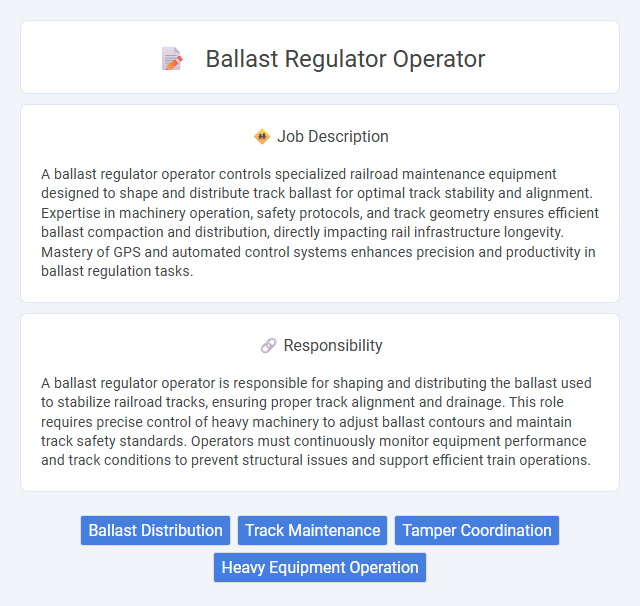
A ballast regulator operator controls specialized railroad maintenance equipment designed to shape and distribute track ballast for optimal track stability and alignment. Expertise in machinery operation, safety protocols, and track geometry ensures efficient ballast compaction and distribution, directly impacting rail infrastructure longevity. Mastery of GPS and automated control systems enhances precision and productivity in ballast regulation tasks.
Individuals with strong attention to detail and good physical stamina are likely suitable for the ballast regulator operator job, as it requires operating heavy machinery to maintain railroad tracks. Those who may struggle with repetitive tasks or have difficulty maintaining focus over long periods might find the role challenging. A basic understanding of mechanical systems and a commitment to safety protocols could increase the probability of success in this position.
Qualification
A Ballast Regulator Operator must possess a high school diploma or GED, accompanied by specialized training in railway maintenance equipment operation. Extensive knowledge of track ballast distribution, machinery controls, and safety protocols is essential for effective performance. Certification or licensing in heavy equipment operation enhances job qualifications, ensuring adherence to industry standards and operational efficiency.
Responsibility
A ballast regulator operator is responsible for shaping and distributing the ballast used to stabilize railroad tracks, ensuring proper track alignment and drainage. This role requires precise control of heavy machinery to adjust ballast contours and maintain track safety standards. Operators must continuously monitor equipment performance and track conditions to prevent structural issues and support efficient train operations.
Benefit
A Ballast Regulator Operator position likely offers competitive wages due to the specialized skills required for maintaining proper track alignment and distribution of ballast. The role may provide strong job stability given the ongoing demand for railroad infrastructure maintenance across various regions. Opportunities for career advancement and skill development in heavy machinery operation could also be significant benefits within this field.
Challenge
Operating a ballast regulator likely involves managing complex machinery to ensure precise ballast distribution on railroad tracks, posing technical and physical challenges. The operator may frequently encounter unpredictable track conditions requiring quick adjustments and problem-solving skills. Proficiency in handling equipment and maintaining safety standards is probably essential to overcome operational difficulties.
Career Advancement
Ballast regulator operator positions offer opportunities for career advancement into supervisory roles, track maintenance management, and specialized railroad engineering fields. Gaining expertise in ballast distribution technology and safety protocols can lead to higher-paying roles such as track foreman or equipment trainer. Continuous skill development and certification in railway operations enhance prospects for leadership positions within railroad maintenance teams.
Key Terms
Ballast Distribution
A Ballast Regulator Operator expertly manages ballast distribution to ensure optimal track stability and alignment. Precise control of ballast placement enhances railbed durability and supports safe train operations by evenly spreading gravel along railroad tracks. Proficiency in operating ballast regulators and monitoring ballast flow rates is critical for maintaining high-quality track infrastructure.
Track Maintenance
A Ballast Regulator Operator expertly manages specialized machinery to shape, redistribute, and smooth ballast along railway tracks, ensuring optimal track alignment and stability. This role demands precise control of equipment such as plows, brooms, and rakes to maintain proper ballast height and profile, directly contributing to safer rail operations and extended track life. Proficiency in track maintenance protocols and adherence to safety regulations are essential for effective ballast regulation and overall infrastructure integrity.
Tamper Coordination
A Ballast Regulator Operator specializing in Tamper Coordination expertly manages the alignment and distribution of ballast to ensure track stability and safety. This role requires precise control of machinery to coordinate with tamping operations, optimizing track geometry and enhancing railroad durability. Skilled operators contribute to minimizing track maintenance downtime while improving overall rail infrastructure performance.
Heavy Equipment Operation
A Ballast Regulator Operator specializes in heavy equipment operation to maintain and shape railroad ballast, ensuring track stability and alignment. Proficient in handling ballast regulators, graders, and other specialized machinery, they perform precise adjustments to the track bed using advanced control systems. Expertise in heavy equipment operation directly impacts railroad safety, track durability, and efficient maintenance workflows.
 kuljobs.com
kuljobs.com